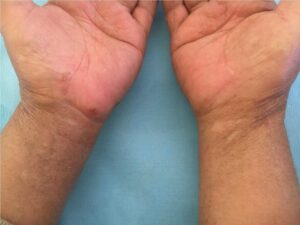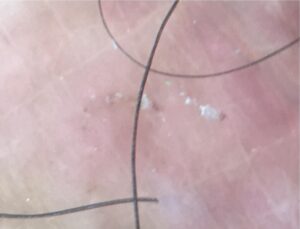Pruritus in mycosis fungoides patients: Always consider scabies
Fatima Zahra Hashas , Sara Elloudi, Sokaina Chhiti, Zakia Douhi, Meryem Soughi, Hanane Baybay, Fatima-Zahra Mernissi
, Sara Elloudi, Sokaina Chhiti, Zakia Douhi, Meryem Soughi, Hanane Baybay, Fatima-Zahra Mernissi
Department of Dermatology, University Hospital Hassan II, Fes, Morocco
Citation tools:
Copyright information
© Our Dermatology Online 2024. No commercial re-use. See rights and permissions. Published by Our Dermatology Online.
Sir;
Pruritus is a frequent symptom and a tool for prognosis and monitoring during mycosis fungoides, but the causes can be multiple, so vigilance for this symptom is required.
We report the case of two patients aged 59 and 29 years followed in our dermatology department for mycosis fungoides evolving for 5 years, they were put on dermocorticoids, phototherapy then methotrexate with good improvement. Both patients reported recent appearance of intense pruritus with nocturnal recrudescence and a notion of family pruritus. The clinical examination found grooves, pearled vesicles, and scratching streaks located in the interdigital spaces, anterior faces of the wrists (Fig. 1a), and reddish-brown nodules on the external genitalia. Demoscopy revealed a positive delta sign with scabial grooves opposite the lesions (Fig. 1b), confirming the diagnosis of scabies.
Mycosis fungoides is the most common form of cutaneous T-cell lymphoma and is characterized by a chronic and recurrent course [1]. The choice of therapy depends on several important considerations, including the stage of the disease, the age of the patient, comorbidities, and the severity of symptoms, including pruritus, which is a means of assessing the prognosis and monitoring the disease [2]. Careful vigilance towards a recent exacerbation of pruritus in mycosis fungoides before wrongly concluding refractory mycosis fungoides or disease progression is a must and should lead to a clinical re-evaluation with precise characteristics of pruritus, the type of lesions, their preferred site, and a meticulous dermoscopic examination in order to eliminate scabies, which requires an effective treatment to limit the spread and contagion [3].
In both cases, clinical field and immunosuppressive treatments created a significant local immunodepression that favored the proliferation of sarcoptes, but vigilance with regard to pruritus made it possible to make an early diagnosis of scabies with an effective treatment with benzyl benzoate.
Consent
The examination of the patient was conducted according to the principles of the Declaration of Helsinki.
REFERENCE
1. Statescu L, Vata D, Solovastru LG. Mycosis fungoides –case presentation. Our Dermatol Online. 2014;5:437-8.
2. Jawed SI, Myskowski PL, Horwitz S, Moskowitz A, Querfeld C. Primary cutaneous T-cell lymphoma (mycosis fungoides and Sézary syndrome):part II. Prognosis, management, and future directions. J Am Acad Dermatol. 2014;70:223.e1-17.
3. Roberts LJ, Huffam SE, Currie BJ. Crusted scabies:clinical and immunological findings in seventy-eight patients and a review of the literature. J infect. 2005;50:375–81.
Notes
Request permissions
If you wish to reuse any or all of this article please use the e-mail (brzezoo77@yahoo.com) to contact with publisher.
| Related Articles | Search Authors in |
|
 http://orcid.org/0000-0002-5360-337X http://orcid.org/0000-0002-5360-337X http://orcid.org/0000-0002-5942-441X http://orcid.org/0000-0002-5942-441X http://orcid.org/0009-0000-6899-8637 http://orcid.org/0009-0000-6899-8637 http://orcid.org/0000-0003-3455-3810 http://orcid.org/0000-0003-3455-3810 |






Comments are closed.